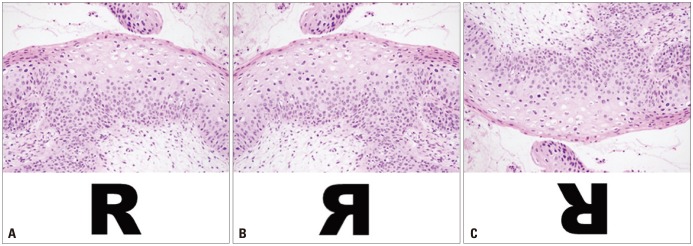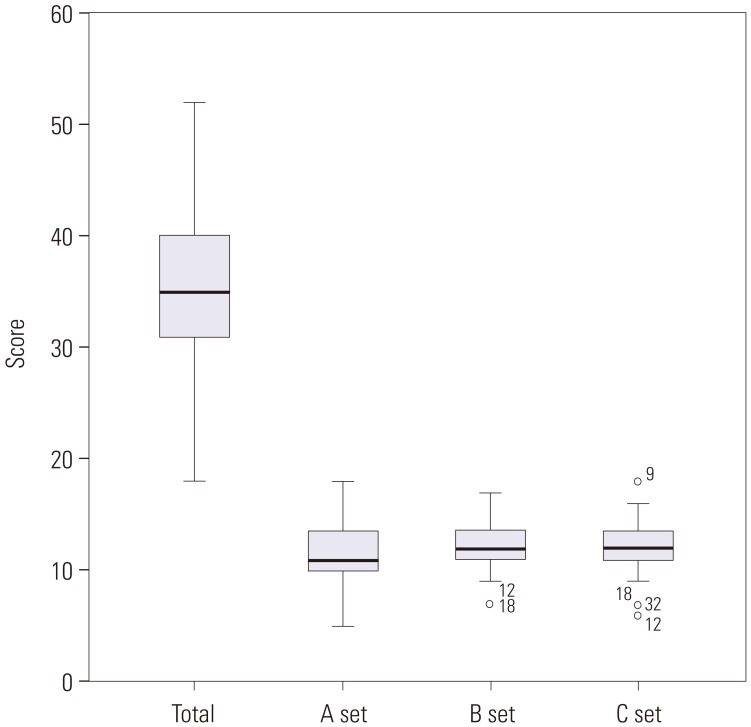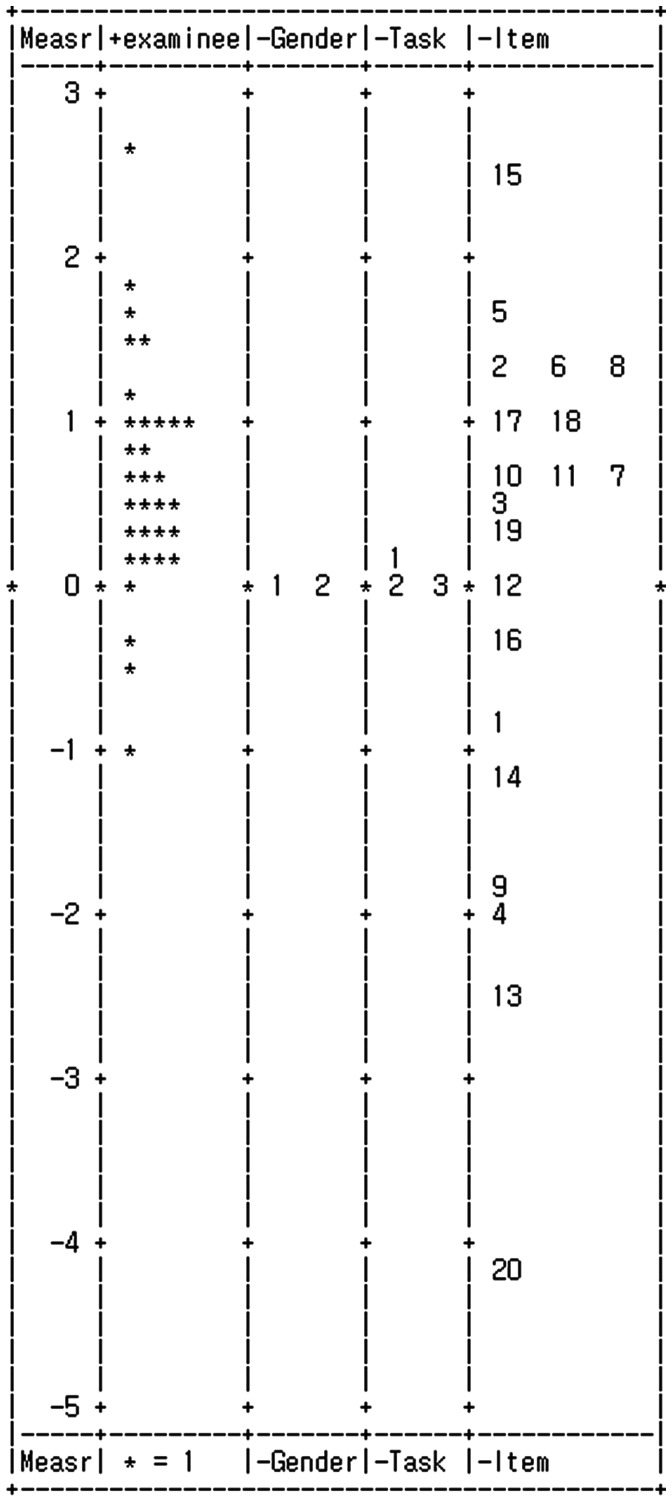Yonsei Med J.
2018 May;59(3):445-451. 10.3349/ymj.2018.59.3.445.
The Effect of Mental Rotation on Surgical Pathological Diagnosis
- Affiliations
-
- 1Department of Pathology, National Health Insurance Service Ilsan Hospital, Goyang, Korea.
- 2Graduate School, Yonsei University College of Medicine, Seoul, Korea.
- 3Department of Pathology, Yonsei University College of Medicine, Severance Hospital, Seoul, Korea. paxco@yuhs.ac
- 4Department of Pathology, Yonsei University College of Medicine, Gangnam Severance Hospital, Seoul, Korea.
- 5College of Pharmacy, Yonsei Institute of Pharmaceutical Sciences, Yonsei Univesity, Incheon, Korea.
- 6Department of Neurology, Kangnam Sacred Heart Hospital, Hallym University, Seoul, Korea.
- 7Department of Surgery, Yonsei University College of Medicine, Severance Hospital, Seoul, Korea. kskim88@yuhs.ac
- 8Department of Medical Education, Yonsei University College of Medicine, Severance Hospital, Seoul, Korea.
- KMID: 2407869
- DOI: http://doi.org/10.3349/ymj.2018.59.3.445
Abstract
- PURPOSE
Pathological diagnosis involves very delicate and complex consequent processing that is conducted by a pathologist. The recognition of false patterns might be an important cause of misdiagnosis in the field of surgical pathology. In this study, we evaluated the influence of visual and cognitive bias in surgical pathologic diagnosis, focusing on the influence of "mental rotation."
MATERIALS AND METHODS
We designed three sets of the same images of uterine cervix biopsied specimens (original, left to right mirror images, and 180-degree rotated images), and recruited 32 pathologists to diagnose the 3 set items individually.
RESULTS
First, the items found to be adequate for analysis by classical test theory, Generalizability theory, and item response theory. The results showed statistically no differences in difficulty, discrimination indices, and response duration time between the image sets.
CONCLUSION
Mental rotation did not influence the pathologists' diagnosis in practice. Interestingly, outliers were more frequent in rotated image sets, suggesting that the mental rotation process may influence the pathological diagnoses of a few individual pathologists.
MeSH Terms
Figure
Reference
-
1. Bussolati G. Dissecting the pathologist's brain: mental processes that lead to pathological diagnoses. Virchows Arch. 2006; 448:739–743. PMID: 16550394.
Article2. Pena GP, Andrade-Filho JS. How does a pathologist make a diagnosis? Arch Pathol Lab Med. 2009; 133:124–132. PMID: 19123724.
Article3. Ackerman AB. An algorithmic method for histologic diagnosis of inflammatory and neoplastic skin diseases by analysis of their patterns. Am J Dermatopathol. 1985; 7:105–107. PMID: 4025726.4. Ackerman AB. Differentiation of benign from malignant neoplasms by silhouette. Am J Dermatopathol. 1989; 11:297–300. PMID: 2672857.5. Barnhill RL, Jones DM. Introduction to microscopic interpretation. In : Branhill RL, Crowson AN, Magro CM, Piepkorn MW, editors. Textbook of dermatopathology. 1st ed. McGraw-Hill;1998. p. 3–15.6. Roa-Peña L, Gómez F, Romero E. An experimental study of pathologist’s navigation patterns in virtual microscopy. Diagn Pathol. 2010; 5:71. PMID: 21087502.
Article7. McLendon RE. Errors in surgical neuropathology and the influence of cognitive biases: the psychology of intelligence analysis. Arch Pathol Lab Med. 2006; 130:613–616. PMID: 16683873.
Article8. Shepard RN, Metzler J. Mental rotation of three-dimensional objects. Science. 1971; 171:701–703. PMID: 5540314.
Article9. Darragh TM, Colgan TJ, Cox JT, Heller DS, Henry MR, Luff RD, et al. The Lower Anogenital Squamous Terminology Standardization Project for HPV-Associated Lesions: background and consensus recommendations from the College of American Pathologists and the American Society for Colposcopy and Cervical Pathology. Arch Pathol Lab Med. 2012; 136:1266–1297. PMID: 22742517.10. Bland JM, Altman DG. Cronbach's alpha. BMJ. 1997; 314:572. PMID: 9055718.11. Cangelosi JS. Designing tests for evaluating student achievement. New York: Longman;1990.12. Ebel RL. Measuring educational achievement. Englewood Cliffs (NJ): Prentice-Hall;1965.13. Linacre JM. What do infit and outfit, mean-square and standardized mean? Rasch Measurement Transactions. 2002; 16:878.14. Cooper LA, Shepard RN. The time required to prepare for a rotated stimulus. Mem Cognit. 1973; 1:246–250.15. Cooper LA, Shepard RN. Chromometric studies of the rotation of mental images. In : Chase WG, editor. Visual informatino processing. New York: Academic Press;1973. p. 75–176.16. Awopeju OA, Afolabi ERI. Comparative analysis of classical test theory and item response theory based item parameter estimates of senior school certificate mathematics examination. EurSci J. 2016; 12:263–284.17. Hambleton RK, Jones RW. Comparison of classical test theory and item response theory and their applications to test development. Educ Meas-Issues Pra. 1993; 12:38–47.18. Hambleton RK, Swaminathan H. Item response theory: principles and application. Boston: Kluwer;1985.19. Harris D. Comparison of 1-, 2-, and 3-parameter IRT models. Educ Meas-Issues Pra. 1989; 8:35–41.
Article20. Tavakol M, Brennan RL. Medical education assessment: a brief overview of concepts in generalizability theory. Int J Med Educ. 2013; 4:221–222. PMID: 28035055.
Article21. Webb NM, Shavelson RJ. Generalizablity theory: overview. In : Everitt BS, Howell D, editors. Encyclopedia of statistics in behavioral science. Chichester: Wiley;2005. p. 599–612.22. Linacre JM. Vertical rulers in table 6=1A, 2A, 3A, 4A,…. In : Linacre JM, editor. A user's guide to FACETS rasch-model computer programs. Winsteps;2014. p. 168–170.
- Full Text Links
- Actions
-
Cited
- CITED
-
- Close
- Share
- Similar articles
-
- A Study on the Pathological Syndromes and the Insights of the Patients in the Community Mental Health Centers
- Factor Analysis of K-WAIS in a Sample of Patients with Organic Mental Disorder due to Head Trauma
- Factors Influencing Problem and Pathological Gambling in Participants of Horse Race Gambling
- Radiologic Findings of Reversed Intestinal Rotation in Adults: 3 Cases Report
- Diagnostic Value in Percutaneous Needle Biopsy of Pleura




